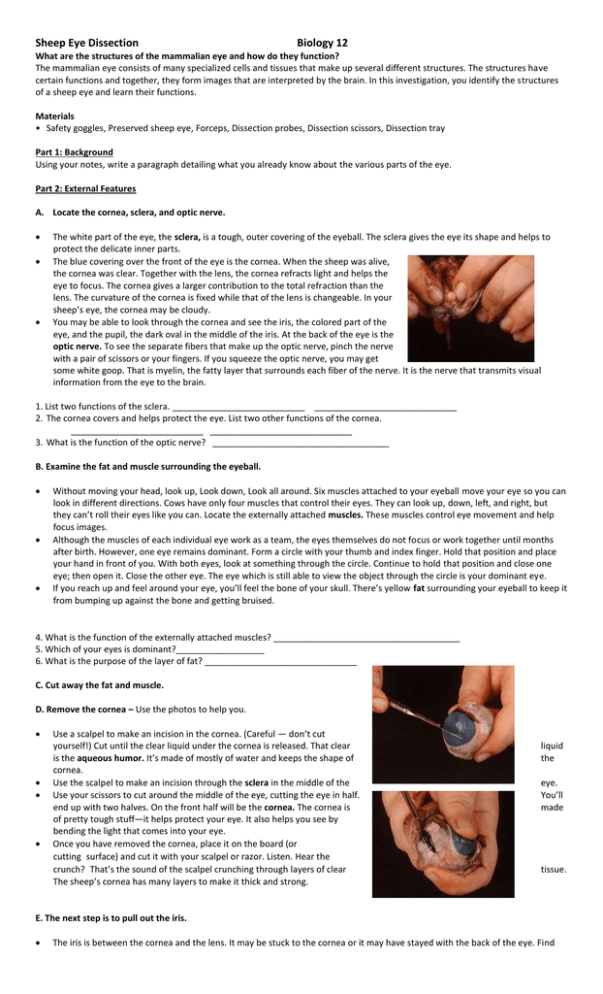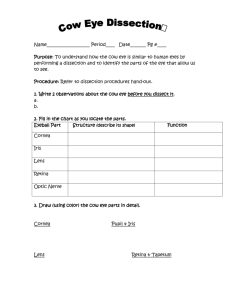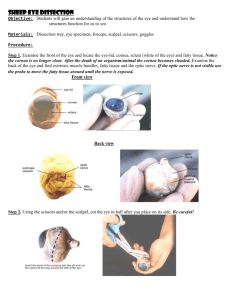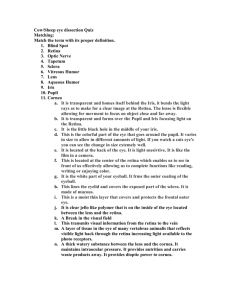Lab-Sheep Eye Dissection
advertisement

Sheep Eye Dissection Biology 12 What are the structures of the mammalian eye and how do they function? The mammalian eye consists of many specialized cells and tissues that make up several different structures. The structures have certain functions and together, they form images that are interpreted by the brain. In this investigation, you identify the structures of a sheep eye and learn their functions. Materials • Safety goggles, Preserved sheep eye, Forceps, Dissection probes, Dissection scissors, Dissection tray Part 1: Background Using your notes, write a paragraph detailing what you already know about the various parts of the eye. Part 2: External Features A. Locate the cornea, sclera, and optic nerve. The white part of the eye, the sclera, is a tough, outer covering of the eyeball. The sclera gives the eye its shape and helps to protect the delicate inner parts. The blue covering over the front of the eye is the cornea. When the sheep was alive, the cornea was clear. Together with the lens, the cornea refracts light and helps the eye to focus. The cornea gives a larger contribution to the total refraction than the lens. The curvature of the cornea is fixed while that of the lens is changeable. In your sheep’s eye, the cornea may be cloudy. You may be able to look through the cornea and see the iris, the colored part of the eye, and the pupil, the dark oval in the middle of the iris. At the back of the eye is the optic nerve. To see the separate fibers that make up the optic nerve, pinch the nerve with a pair of scissors or your fingers. If you squeeze the optic nerve, you may get some white goop. That is myelin, the fatty layer that surrounds each fiber of the nerve. It is the nerve that transmits visual information from the eye to the brain. 1. List two functions of the sclera. ___________________________ _____________________________ 2. The cornea covers and helps protect the eye. List two other functions of the cornea. ___________________________ _____________________________ 3. What is the function of the optic nerve? ____________________________________ B. Examine the fat and muscle surrounding the eyeball. Without moving your head, look up, Look down, Look all around. Six muscles attached to your eyeball move your eye so you can look in different directions. Cows have only four muscles that control their eyes. They can look up, down, left, and right, but they can’t roll their eyes like you can. Locate the externally attached muscles. These muscles control eye movement and help focus images. Although the muscles of each individual eye work as a team, the eyes themselves do not focus or work together until months after birth. However, one eye remains dominant. Form a circle with your thumb and index finger. Hold that position and place your hand in front of you. With both eyes, look at something through the circle. Continue to hold that position and close one eye; then open it. Close the other eye. The eye which is still able to view the object through the circle is your dominant eye. If you reach up and feel around your eye, you’ll feel the bone of your skull. There’s yellow fat surrounding your eyeball to keep it from bumping up against the bone and getting bruised. 4. What is the function of the externally attached muscles? ______________________________________ 5. Which of your eyes is dominant?__________________ 6. What is the purpose of the layer of fat? _______________________________ C. Cut away the fat and muscle. D. Remove the cornea – Use the photos to help you. Use a scalpel to make an incision in the cornea. (Careful — don’t cut yourself!) Cut until the clear liquid under the cornea is released. That clear is the aqueous humor. It’s made of mostly of water and keeps the shape of cornea. Use the scalpel to make an incision through the sclera in the middle of the Use your scissors to cut around the middle of the eye, cutting the eye in half. end up with two halves. On the front half will be the cornea. The cornea is of pretty tough stuff—it helps protect your eye. It also helps you see by bending the light that comes into your eye. Once you have removed the cornea, place it on the board (or cutting surface) and cut it with your scalpel or razor. Listen. Hear the crunch? That’s the sound of the scalpel crunching through layers of clear The sheep’s cornea has many layers to make it thick and strong. liquid the eye. You’ll made tissue. E. The next step is to pull out the iris. The iris is between the cornea and the lens. It may be stuck to the cornea or it may have stayed with the back of the eye. Find the iris and pull it out. It should come out in one piece. You can see that there’s a hole in the center of the iris. That’s the pupil, the hole that lets light into the eye. The iris contracts or expands to change the size of the pupil. In dim light, the pupil opens wide to let light in. In bright light, the pupil shuts down to block light out. The back of the eye is filled with a clear jelly. That’s the vitreous humor, a mixture of protein and water. It’s clear so light can pass through it. It also helps the eyeball maintain its shape. The vitreous humor is attached to the lens. F. Now you want to remove the lens. It’s a clear lump about the size and shape of a squashed marble. The lens is a transparent structure in the eye that, along with the cornea, helps to refract and focus light. the A ring of tiny ciliary muscles, located along the inner side of the iris, connects lens to the middle layer of the eye. Ciliary muscles contract to change the curvature of the lens. The lens of the sheep’s eye feels soft on the outside and hard in the middle. Hold the lens up and look through it. In a living organism, it is completely transparent. (Your sheep lens may not be transparent.) To focus on closer objects, it gets fatter so it can refract more light. Put the lens down on this lab sheet and look through it at the words on the page. If your lens is transparent, it should magnify. 7. List the two functions of the lens. •_______________________ •___________________ 8. Describe the iris and explain its function. _________________________________________________ 9. Describe the pupil. ____________________________________________________________ 10. If you enter a very bright room after being in the dark, what would happen to your pupils – get larger or get smaller? _______________________________ G. Now it’s time to examine the retina. If the vitreous humor is still in the eyeball, empty it out. On the inside of the back half of the eyeball, you can see some blood vessels that are part of a thin fleshy film. That film is the retina. Before you cut the eye open, the vitreous humor pushed against the retina so that it lay flat on the back of the eye. It may be all pushed together in a wad now. The retina is made of cells that can detect light. The eye’s lens uses the light that comes into the eye to make an image, a picture made of light. That image lands on the retina. The cells of the retina react to the light that falls on them and send messages to the brain. Use your finger to push the retina around. The retina is attached to the back of the eye at just one spot. Can you find that spot? That’s the place where nerves from all the cells in the retina come together. All these nerves go out the back of the eye, forming the optic nerve, the bundle of nerves that carries messages from the eye to the brain. The brain uses information from the retina to make a mental picture of the world. The spot where the retina is attached to the back of the eye is called the blind spot. Because there are no light-sensitive cells (photoreceptors) at that spot, you can’t see anything that lands in that place on the retina. 11. Why does the optic nerve cause a blind spot? Be specific. ____________ H. Check out the tapetum Lucidum – the pretty part! Under the retina, the back of the eye is covered with shiny, blue- green stuff. This the tapetum. It reflects light from the back of the eye. Have you ever seen a cat’s eyes shining in the headlights of a car? Cats, like sheep, have a tapetum. A cat’s seems to glow because the cat’s tapetum is reflecting light. If you shine a light at sheep at night, the sheep’s eyes will shine with a blue-green light because the reflects from the tapetum. Humans do not have this tapetum. is eye a light I. Find your blind spot. To find your blind spot, use the two dots below. Hold one hand over your left eye and look directly at the left-hand dot. At first, you can see both dots even though you're looking directly at only one. As you slowly move the page closer to your eyes, the right-hand dot disappears! If you move your eye, the dot will reappear, but as long as you focus on the first dot, the second will be invisible. Move even closer and the missing dot reappears. You’ve found your blind spot! Analysis Questions 11. Eye structure Function – indicate the functions of the following structures: External muscles Retina, Cornea, Lens Optic nerve Iris, sclera, ciliary muscles 12. Name two physical differences between the sheep eye and the human eye. __________________ 13. What would happen to sight if the optic nerve becomes damaged? 14. What part of the brain receives the signals from the eye? 15. What would happen to your vision if something damaged the retina? 16. What causes the pupil to open and close? 17. Describe the pathway of light as it enters the eye.








